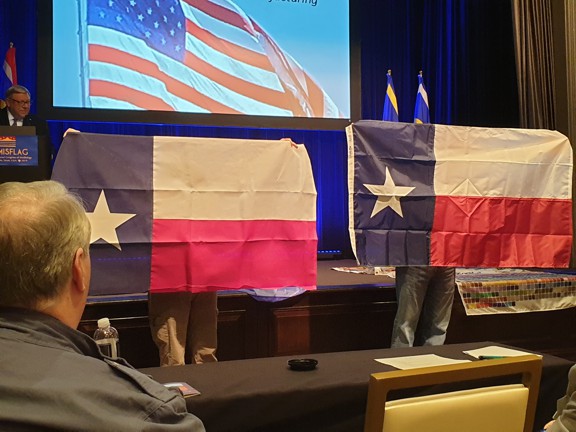 image by Bruce Berry, 15 July 2019
image by Bruce Berry, 15 July 2019[Click on image for larger version]

Last modified: 2020-01-18 by rob raeside
Keywords: international congress of vexillology | san antonio |
Links: FOTW homepage |
search |
disclaimer and copyright |
write us |
mirrors
See also:
The proceedings commenced with the FIAV anthem being played and the FIAV Board members, Michel Lupant, Charles Spain and Graham Bartram, together with Hugh Brady of the Organizing Committee, entering the Congress Venue at the St Anthony Hotel, carrying the FIAV Gavel. The welcoming address was given by the City Protocol Officer of San Antonio. She mentioned that San Antonio celebrated its 300th anniversary in 2018 and will be celebrating its 300th anniversary of having a civil government in 2031, and having played a central role in the political development of Texas, had seen all six flags which have flown over Texas.
 image by Bruce Berry, 15 July 2019
image by Bruce Berry, 15 July 2019
[Click on image for larger
version]
Further introductory remarks were given by Hugh Brady and Vanessa van de Putte, the Congress Director , who also introduced the youngest members of the Congress who are under 18 years old. Graham Bartram, FIAV Secretary-General for Congresses, then thanked the organizers, hosts and attendees before handing over the podium to FIAV President, Michel Lupant, who then formally opened the Congress.
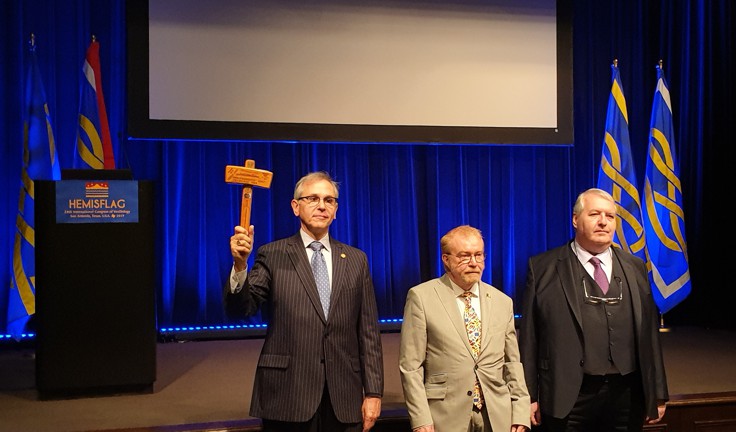 image by Bruce Berry, 15 July 2019
image by Bruce Berry, 15 July 2019
[Click on image for larger
version]
The theme of the first plenary session was Flag Design and Colours. The first speaker was John Hartvigsen whose presentation focussed on the need revisit current attitudes to flag design principles are based on the work of John Purcell and Peter Orenski in 2001. This was followed by Good Flag, Bad Flag by Ted Kaye and more recently dealt with by Tony Burton. John made the point that flag design is an art, not a science, and that sometimes vexillologists and vexillographers get fixated on the design principles and neglect the need to consider who or what the flag represents whereas ultimately diversity in design needs to be encouraged.
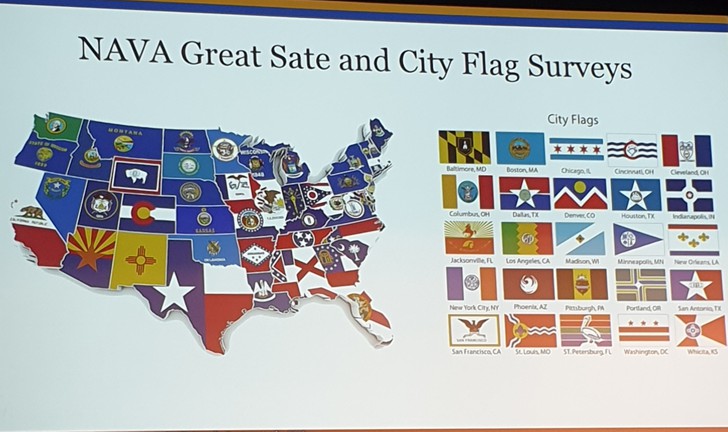 image by Bruce Berry, 15 July 2019
image by Bruce Berry, 15 July 2019
[Click on image for larger
version]
This was followed by a very interesting (and technical) presentation by Mike Thomas from Luxembourg. His presentation was called 'Recognising Flags by their mean Colour". Mike showed that on 29 March 2019 there were 140 000 images on FOTW and that of the colour pixels using the 16 million RGB (red, green, blue) for digital images, the mean and standard deviation of flags is 35 colours apart. He showed how this could be applied for the flags of Sweden (50 colour units apart) and Antigua and Barbuda (58 units apart), ending his presentation asking the question is there a use for such methodology?
This theme of colour and colour variations was continued in the following presentation given by Pete van de Putte of Dixie Flags. He outlined the difficulty in trying to determine the correct colour specifications for flags to match customer demands and how colours can vary when seen in the sunlight etc. He showed various colour charts used by the flag manufacturers and how these had changed over the years. He also showed colour swatches and different flags to emphasise the colour variations.
The last session before lunch was an very interesting and amusing figurative overview of "red flag" given by John Cartledge from the UK. He began by indicating that red flags feature symbolically in many forms of life and that now "red flag" is even a compound verb. John then showed many examples from cartoonists, pop groups, the theatre etc how a "red flag" generally has negative connotations ...
After lunch Pierre-Jean Guionin from SHOM in France provided an overview of the Bicentenary of the Album des pavillons, showing how the need to describe and illustrate flags in sea battles resulted in the first edition of the Album in 1819, and how it has been regularly updated and reprinted ever since. The 9th edition in 2000 was the first to be bilingual (French/English) and in 2013 saw the first online edition with 2260 flag images. The 11th edition has just been published and future editions and updates will only available online.
Charles Spain (USA) then told the story of how Whitney Smith's collection at the Flag Research Center came to finally find a new permanent home at the Briscoe Center at the University of Texas. Delegates will be visiting the Briscoe Center during the Conference Excursion on Wednesday.
Finally, Gus Tracchia (USA) presented a paper co-authored with Franciso Gregoric (FOTW editor) from Argentina on flags and sashes, particularly as used in Latin America. The sash denotes authority and examples were provided of the sash being worn by the presidents in Latin America, as well as by some Governors in Argentina, and how these are similar to the national flags in these countries.
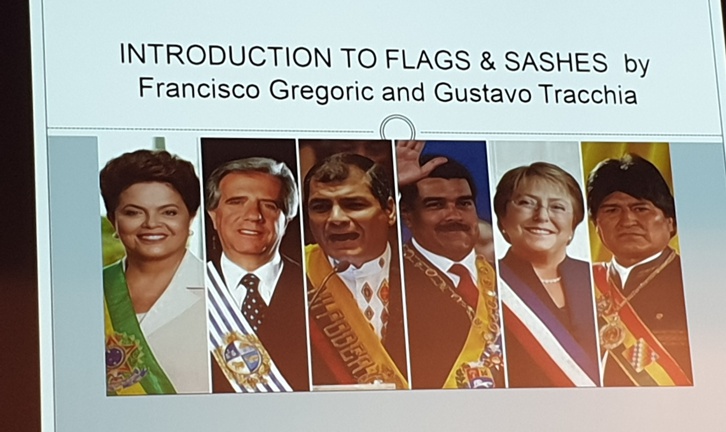 image by Bruce Berry, 15 July 2019
image by Bruce Berry, 15 July 2019
[Click on image for larger
version]
It was a most interesting and informative day with the attendees making use of the breaks to catch up with old friends and make new ones.
The last event of the day was a tour of The Alamo, the historic Spanish mission and fortress compound founded in the 18th century by Roman Catholic missionaries and site of the Battle of the Alamo in 1836 eventually leading to Texas becoming a republic before joining the United States as the 28th state in 1845.
Tomorrow there are further presentations and the General Assembly of FIAV will meet in the afternoon. FOTW contributors at the congress will gather after the GA to chat about issues of mutual interest.
Bruce Berry, 15 July 2019
Day Two of the ICV kicked off with a presentation by Željko Heimer from Croatia on the flag controversies surrounding the flag of Rijeka/Fiume. A coat of arms for the city incorporating a double-headed eagle was first approved by Leopold I in 1659. Much later in 1814 a flag based on the Austrian flag defaced by the city arms was adopted. The flag underwent a number of changes in 1835, 1848, 1849, 1858 and 1870 before it became the Free State of Fiume in 1919 after which it used an Italian Gonfalon. The city was annexed to Italy under the Treaty of Rome in 1923 when a single-headed (Roman) eagle was used on the Arms. A city flag was officially adopted in 1935 and used until the German occupation in 1943. In 1945 Yugoslav partisans took over the city and it was not until 1967 that an entirely new flag was designed with the somewhat unusual proportion of being in the ratio of 1:4. A modernised version of the historical flag was designed in 1998 which was approved. In 2016 another request was made to the authorities to approve the design n the city flag but this too has not yet been approved.
Keeping to the "European" theme was the paper presented by Aleksander Hribovsek from Slovenia on the Flags used by the Slovenian Armed Forces. In May 1991, prior to the independence of the Republic of Slovenia, a new flag for the newly created Slovenian Armed Forces was created. Aleksander then outlined the protocol for the flying, folding, storage and unfolding of the Slovenian flag. He also showed images of the various regimental and rank flags, the Slovenian naval flag and jack, the former being the same as the national flag and the latter being three horizontal stripes of white, blue and yellow.
The last presentation of this session was on the Flags of Mount Athos by FIAV President, Michel Lupant. Mount Athos is a 'holy mountain' in northern Greece which has 1200 inhabitants, mostly monks. Michel showed photos of a trip he made to the area. The local symbol is a double-headed eagle from the Byzantine period, which is found on various official documents, including local flags.
After the break Andreas Herzfeld informed the meeting about two historical German flag books which have recently been discovered. Triplecodex was printed during the Triple Alliance between Germany, Austria-Hungary and Italy which was in force between 1882 and 1912 but was never used. A copy of Flaggenbuch, the German flag book, printed in 1893 was discovered by Jorg Karachewski in 2018. Interestingly, the current owner of the book found it in London 20 years ago. Much to the delight of the audience, Andreas showed some illustrations from this book.
The last presentation before lunch was by Rachel Phelan from Ireland on Two Historic Irish Unionist Flags - the 36th Ulster Base Depot Flag from 1914 and "King Billy" from the Battle of the Boyne in 1690. Rachel explained the symbolism behind the "Red Hand of Ulster", its use on the "official" flag of Northern Ireland between 1953 and 1973 and that it is still widely used by Unionists. The "King Billy" flag continues to arouse emotions and while funds efforts to conserve the flag have been raised, no funding has been secured to finance its display. Rachel's presentation highlighted the point that flags can be divisive and the dynamics around their display need to be understood.
The session after lunch was National Identity and Cultural Vexillology with the first presentation being by Tracey Mee (Australia) on the topic of her recently completed doctoral thesis, National Identity through a vexillological lens. Tracey highlighted the Australian situation whereby the current national flag is not considered to be representative of all the peoples of Australia and that there is still a need for a 'flag for all Australians'.
The next presentation was by Annie Platoff (USA) on Banal Nationalism in the USSR: State Symbols in the Daily Lives of Soviet Citizens. Annie showed how the flags, together with bank notes, coins, postage stamps, holiday cards and unity displays, etc., were used to reinforce the political and ideological socialisation of citizens in the USSR.
The last presentation was by Dr. Scot Guenter (USA) via video link. Scot discussed the Plenitude of Opportunities: An Exhortation for Contemporary Vexillology. In these somewhat turbulent times he contends, the time is ripe for a deeper investigation and analysis of contemporary flag evidence. Scot provided 5 categories where more critical thinking is required. Flag studies can and should provide a greater service in helping to understand how identity - both individual and collective - can be maintained and enhanced.
The plenary session was followed by the 26th meeting of the FIAV General Assembly. 46 FIAV members were present and following decisions were voted on and agreed to:
- FIAV membership for the Macedonian Heraldry Society, the Chilean National Vexillological Association and the Chinese Centre for Vexillological Studies;
- the election of a new Board for 2019-2021. Michel Lupant and Charles Spain retired as President and Secretary General respectively. The new Board members elected were
Željko Heimer as President and Bruce Berry as Secretary General. Graham Bartram was re-elected as Secretary General for Congresses; and
- the Chinese Centre for Vexillological Studies was elected as the host for ICV 30 in 2023.
Finally, a FOTW meeting was held. There was a lively discussion on the issue of the naming of images, the outcome of the the software improvement/upgraded discussed in London and linkages between the mailing list and Facebook Group. A more detailed report on the issues discussed will be sent to the List Master for consideration.
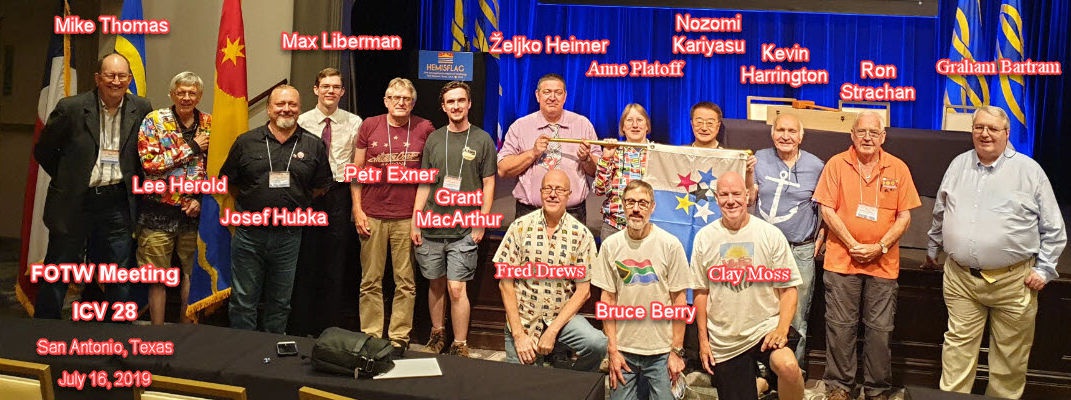 image by Bruce Berry, 15 July 2019
image by Bruce Berry, 15 July 2019
[Click on image for larger
version]
It has been a very busy day. Tomorrow is the excursion to Dixie Flags and to visit the Flag Research Center collection at the Briscoe Center at the the University of Texas in Austin.
Bruce Berry, 16 July 2019
The first stop en route to Austin was a visit to the Dixie Flag Manufacturing Company of which Pete van de Putte, one of the Congress organisers, is President. A giant 50 by 30 feet San Antonio city had been hoisted to greet us and delegates were shown around the company and its operational facilities, before being let loose in the adjacent flag shop! The company is currently in the process of putting together a massive 120 foot US flag cut into the shape of North and South Carolina which was the focus of much attention.
The three busses then headed off to Austin with the first stop being a tour of the State Capitol. ICV delegates were provided with a brief overview of the building by Hugh Brady. The massive three storey red granite structure is the largest capitol building in the United States and is 14 feet higher than the US Capitol building in Washington DC. Of major interest on the floor of the central rotunda is a circular collection of the seals representing the six flags that have flown over Texas, namely Texas under Spain, France, Mexico, the Confederacy surrounding a large Texas seal standing for Texas in the United States. Portraits of the former Governors and Presidents of Texas hang on the walls of the rotunda.
Delegates were then taken to the top of the Dome before going to the library to be shown the original description and illustration of the Texas state flag. Charles Spain explained that the discrepancy in the shade of blue was probably due to the fact that the original having faded after being exposed to sunlight ...
After walking through the Texas House of Representatives and seeing the flag saved from the Battle of San Jacinto in 1836 which hangs behind the Speakers Chair when the house is in session, delegates were treated to lunch in the Lieutenant Governor's Reception Room. Introduced by former Texas Senator Leticia van de Putte, Acting Assistant Secretary of State of Texas, Ed Esparza, welcomed the delegates.
In the afternoon delegates visited the Briscoe Centre at the University of Texas where Whitney Smith's collection has been housed since 2013. Delegates were given an overview of the Centre and shown how to access the material for research purposes. Some examples from Whitney's collection were on display to us a tantalising taste of the type of material is available.
After a long day, the buses stopped at Krause's Biergarten for a welcome drink and a bite to eat before heading back to San Antonio.
That's it for today. The presentations continue tomorrow.
Bruce Berry, 17 July 2019
The theme of the first session was Asia and the first speaker was Nozomi Kariyasu from Japan whose paper was on Japanese Heraldry and Their use on Municipal Flags and their future prospects. Nozomi explained the system of Kamon (family emblems) and their classification by motif. Each of the approx. 20 thousand Kamons have a unique design pattern based on that originally used by the nobility.
Nozomi then went on to outline the origin of the use of the Chrysanthemum as an imperial standard in Japan and then how Japanese prefecture and municipal flags have evolved since the Meiji Restoration. Since 1991 there has been a reduction in the number of municipalities in Japan and this has resulted in a need for new 'neutral' symbols, most of which have been the result of public competitions, with the designs being influenced by Western trained designers. The result has been that Kamon-style designs are diminishing and this trend is likely to continue. He ended his presentation with an illustration of the Kariyasu family Kaman.
The next presentation was by Zhao Xinfeng (China) on the Banners Ceremony in the Mountainous Areas of Beijing which date from the Ming Dynasty. Zhao gave an overview of the traditional banner ceremony which was restored 179 years ago where 6 m long vertical banners, embroidered with religious patterns and prayers, are the focus of a ceremony which commences on the 16th day of the lunar month. It is hoped that this ceremony will be performed for delegates during ICV 30 in 2023.
After the mid-morning break, Dean Thomas showed a short video clip of the the lowering of the last Vietnamese flag aboard the USS Kirk on 7 May 1975. This was one week after the fall of Saigon to the forces of the National Liberation Front (Vietcong). The Kirk was carrying refugees to the Philippines and as the Filipino Government had recognised the new regime in Vietnam, she was refused entry. Dean explained the emotional ceremony how the Vietnamese flag was lowered and the US flag was raised on various ships, which being leased to the South Vietnamese, that as re-flagged vessels they were then allowed to enter Subic Bay in the Philippines.
The final session before lunch was entitled Vexillological Developments in Thailand since 2017. Pluethipol Prachumphol, Jantakarn Kloaisal and Khor Poh Kiang from Thailand explained the protocol for the display of the new Coronation Flag.
A short video on the making of the world largest Buddhist Flag made for the World Buddhist Association on 11 February 2019. The flag is 42 m by 63 m and is 2646 square metres and the intention is to erect a 190 m (63 storey) flagpole in order to hoist and fly it.
Lastly, evidence was provided to show that the use of the white elephant on the flag of Siam occurred during the reign of King Rama III and is illustrated on a French flag chart from 1839. This dispels the current view that the white elephant was only used during after 1851. The white elephant was taken off the flag in 1916.
The next presentation was by Alain Raullet from France on the Flags and Symbols of the French Foreign Legion. Alain showed the flags and symbols of some of the 600 legionnaire units. Initially the regimental colours had the motto Valeur et Discipline and this was later changed to Honneur et Fidelité. This is written on the flag together with unit's Battle Honours.
The day ended with the Neubecker Lecture by Rafael Chacon (USA) entitled Iconografia Jacobea: the Reach of Santiago, Spain's Patron Saint, in Municipal Heraldry and Vexillology. Rafael showed how images of St James (Santiago) can be found in the coats of arms and flags of various towns along the "Milky Way" used by pilgrims in the past, in France, Germany, Poland, Czech Republic and Slovakia. Interestingly in Spain full images of St James are not used and elements such as scallops and shoes, etc., are found in various municipal coats of arms and flags.
Finally, Gus Traccia presented former FIAV President, Michel Lupant, with the Gran Cruz Al Merito "Ottfried Neubecker" on behalf of the Centro Interdisciplinario de Estudios Culturales (CIDEC) for his outstanding service to vexillology.
The plenary session was followed by a NAVA meeting.
Bruce Berry, 18 July 2019
The next presentation in this United States themed session was by Bard Cosman (USA) on Nechushtan in America - Why the Gadsden Flag is Yellow. In this presentation Bard provided a very detailed overview on the reasons for the yellow background and the brown rattlesnake finally concluding that this is the 'brazen serpent banner' with the Gadsden flag sending the message of God's protection and Salvation through Christ.
This was followed by Kevin Harrington (Canada) whose presentation dealt with the post-Depression National Recovery Act (NRA) flag which contained a blue eagle on a white field. The legislation was enacted in June 1933 as part of President Franklin D Roosevelt's New Deal legislative programme. The Act authorised the President to regulate industry in order to stimulate economic growth and established a national public works programme. Although initially welcomed by business, the programme was terminated after the Supreme Court declared it unconstitutional in 1935.
After the break, it was my turn to present. My presentation was on the Zimbabwe Bird and its use in the iconography in Rhodesia, and later Zimbabwe. After being first used on the Rhodesian Coat of Arms in 1924, the Zimbabwe Bird is now the country's predominant symbol which is found on a plethora of local, regional, military and of course, the national flag.
Steve Knowlton (USA) followed with a presentation on the county flags of Liberia. Despite the criticism of their design, these flags which were presented to each county as a gift to instill a "county and territorial spirit" by Pres Tubman in 1965, are stylised in such a way so as to incorporate the country's quilting tradition.
After lunch there was a panel presentation and group discussion on The Future of Vexillological Knowledge and the Ideas for a Central Repository and Digitalisation. Željko Heimer, Annie Platoff and Steve Knowlton were the panel members and provided a background on the issues confronting the preservation and storage of vexillological material and the impact on vexillological institutions. This was followed by a lively discussion from the floor, concluding that there is a need for some kind of international vexillological index.
The final presentation was made by Hugh Brady (USA) on Sketching the Contours of Education in the Auxiliary Sciences of History: A modest proposal for a Graduate Programme in Vexillology. Hugh contends that the advancement of vexillology requires a specific plan on a programme with specific objectives. He proposed a Certificate in Vexillology (Cert.Vex) and a Graduate Certificate in Vexillology (G.Cert. Vex) and provided examples where auxiliary history programmes are already being offered. These could be a basis for future vexillological orientated programmes.
The plenary session ended with Aleksander Hribovsek providing an outline of the programme for ICV29 to be held in Ljubljana, Slovenia (12-16 July 2021). Details about ICV29 are available at ICV29 - Ljubljana 2021 and will be continually updated.
The Congress ended with the traditional final banquet. In keeping with tradition the FIAV Fellow and Laureate Awards were announced. The details of the Awards and their recipients will posted on the FIAV website at http://www.fiav.org.
It has been a very busy and most enjoyable week, but all good things have to come to an end ... we leave more enlightened and ready for the next two years when we come together again.
Bruce Berry, 19 July 2019